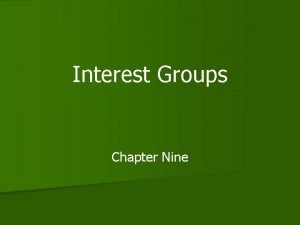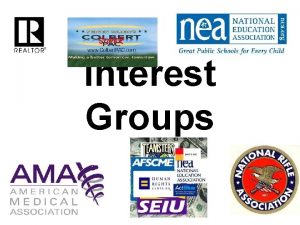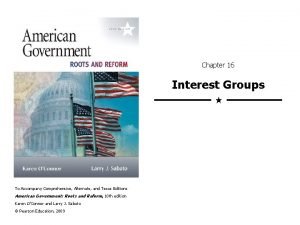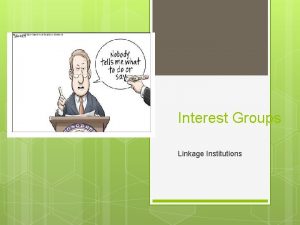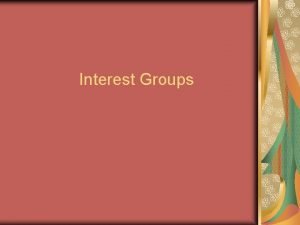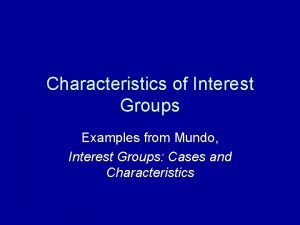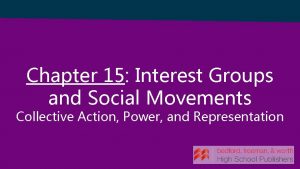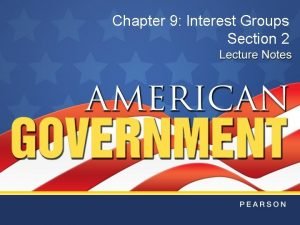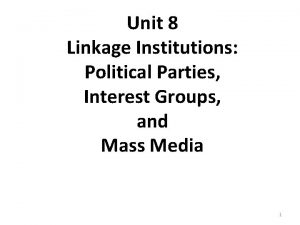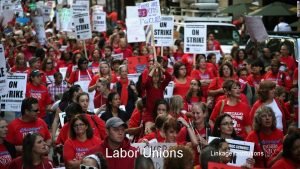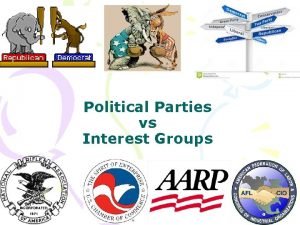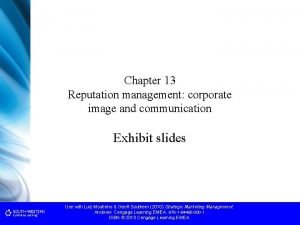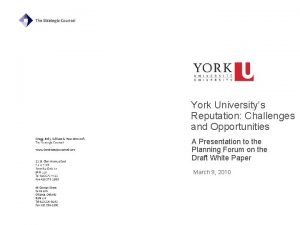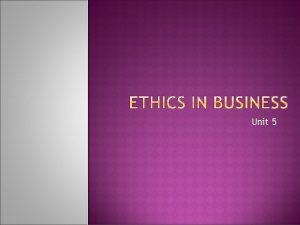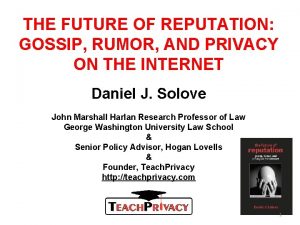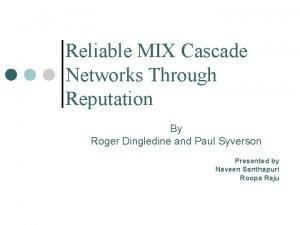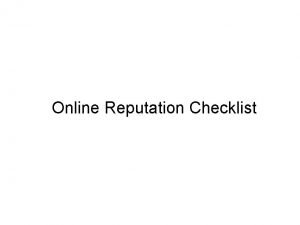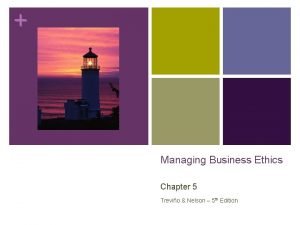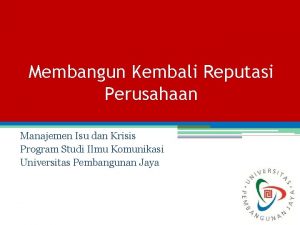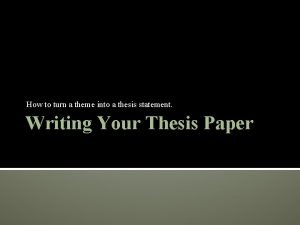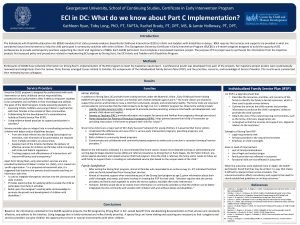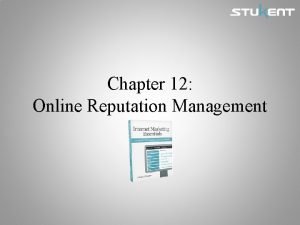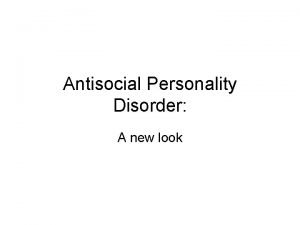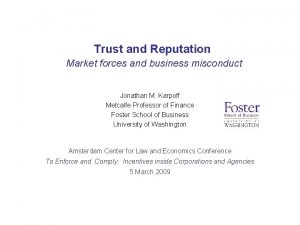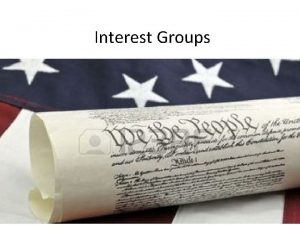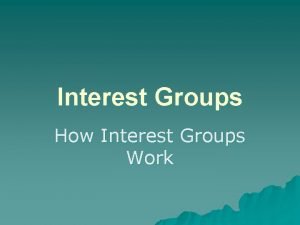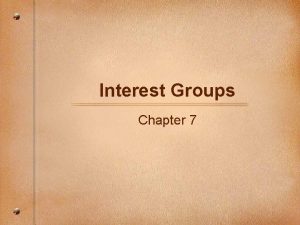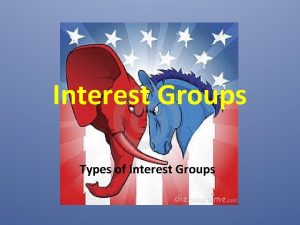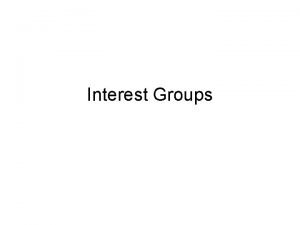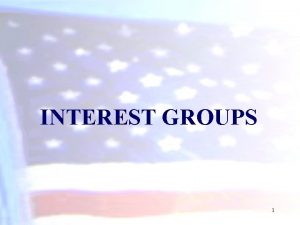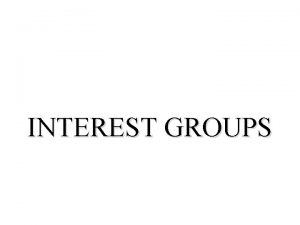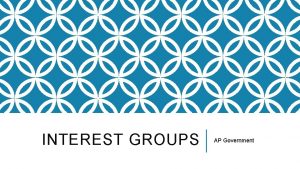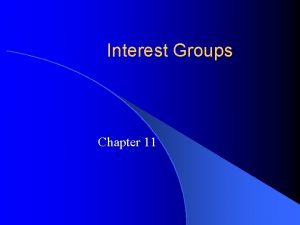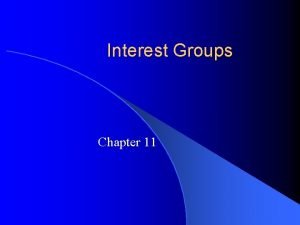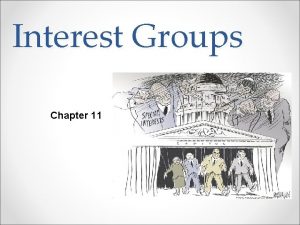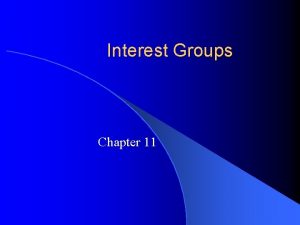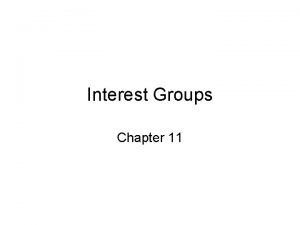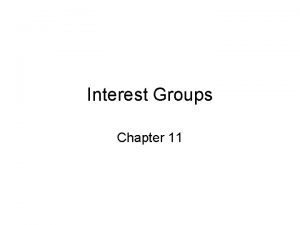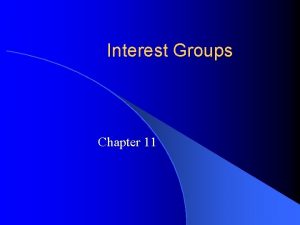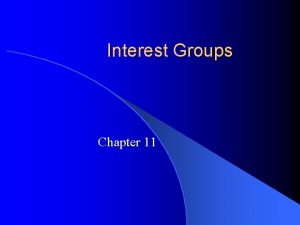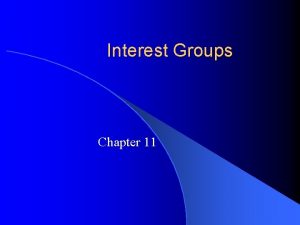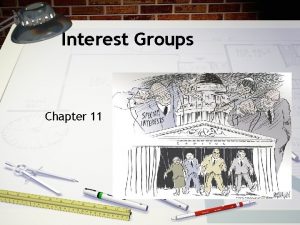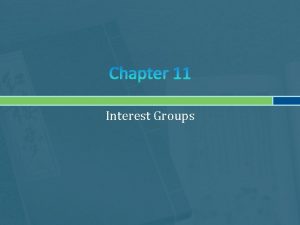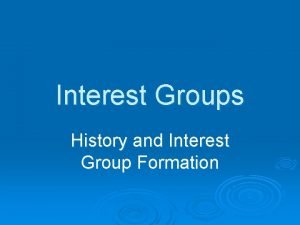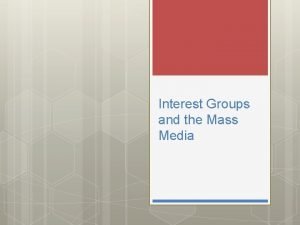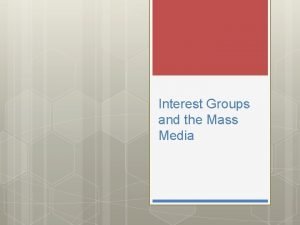Interest Groups I The Role and Reputation of






































- Slides: 38

Interest Groups

I. The Role and Reputation of Interest Groups 1. Voter turnout since 1960= big decline, but participation in interest groups has mushroomed 2. The Freedom to Organize= is fundamental to democratic government

3. Interest groups are not political parties a. An interest group= an organization of people with similar policy goals that tries to influence the political process to achieve these goals b. Interest groups will try influence every branch and level of government to accomplish its goals

c. This multiplicity of policy areas helps distinguish interest groups from political parties d. Interest groups may support candidates for office, but they do not run their own slate of candidates e. Interest groups= policy specialists Political parties= policy generalists f. Unlike political parties- interest groups do not have to worry about appealing to everyone 4. Interest groups and bad press-why? (Crucial to democratic government, but lots of criticism) a. Very negative image- Madison’s Federalist #10

b. lobbying- both dishonest (but also honest) lobbying= major problems for democracy II. Theories of Interest Groups Politics 1. The Pluralist Theory- argues that interest group activity brings representation to all- the many groups compete and counter balance one another 2. Elite Theory- argues that a few groups (mostly the wealthy) have most of the power 3. Hyperpluralist Theory- assumes that too many groups are getting too much of what they want, resulting in a governmental policy that is often contradictory and lacks in direction.

A. Pluralism and Group Theory i. Pluralist theory – the extensive organization of competing groups is seen as evidence that influence is widely dispersed among many groups- groups win some and lose some, but no group wins or loses all of the time ii. A group theory of politics contains some essential arguments. • • Groups = a key link between people and the government Groups compete, and interests constantly make claims to one another.

• • • No one group is likely to become too dominant. If one group grows too powerful, the other groups are likely to intensify their efforts and restore the balance of the system Groups usually play by the rules of the game- few lie, steal, cheat, engage in violence Groups weak in one resource will use another iii. Pluralists do not deny that some groups are stronger than others. • • or that competing interests do not always get an equal hearing But they do argue that lobbying is open to all and should not be regarded as a problem

B. Elites and the denial of pluralism i. Elite theorists maintain that real power is held by a relatively few people, key groups, and institutions– i. e. - government = run by only a few big interests only looking out for themselves ii. Elites point to interlocking and concentrated power centers- about 1/3 of top institutional positions are occupied by people who hold more than one such position iii. The numerous groups prove nothing- because they are extremely unequal in power * Example when consumer interests confront the power of multinational corporations- consumer interest groups are easily pushed aside

iv. Honest lobbying is a problem because it benefits the few at the expense of the many C. Hyperpluralism and interest group liberalism i. Hyperpluralists essential argument= the pluralist system is out of control ii. Theodore Lowi coined the phrase interest group liberalism- to refer to the government’s excessive deference to groups iii. Interest group liberalism= holds that virtually all pressure group demands are legitimate and that the job of the government is too advance them all. iv. In an effort to appease every interestgovernment agencies grow, conflicting regulations expand, programs multiply= the budget sky rockets

D. Interest group liberalism is promoted by the network of sub-governments (also known as iron triangles)- these sub-governments are composed of • • • Key interest groups interested in particular policy The government agency in charge of administering the policy The members of the Congressional committees and sub-committees handling the policy


E. Relations between the government and groups can become too cozy • • Hard choices about national policy are rarely made Because the government is trying to favor all groups= eventual policy paralysis- perfect example= the government’s contradictory tobacco related policies F. The recent explosion of interest groups has caused some to see a weakening of the power of subgovernments- so many interest groups, competing against one another= hard for the government to have a cozy relationship with all of them

III. What makes an interest group successful? • • • The size of the group The intensity Financial resources 1. The Size of the group a. Really large groups can be surprisingly ineffective b. A potential group- is composed of all people who might be group members because they show common interest c. An actual group- those in a potential group who choose to join. Groups vary enormously in the degree to which they enroll their potential membership

d. A collective good is something of value (such as clear air or a higher min. wage) that cannot be withheld from a potential group member. Members of the potential group share in the benefits that members of the actual group work to secure • • Economist Mancur Olson- points out that all groups- as opposed to individuals- provide collective goods. The free rider problem occurs when potential members decide not to join, but to sit back and let others do the work (while they nevertheless benefit) According to Olson- the bigger the group= the more serious the free rider problem

e. - Easier to organize a small group with clear economic goals than it is to organize a large group with broader goals. f. - Small groups have an organizational advantage over large ones because a member’s share of the collective good in a small group may be great enough for he or she to try to secure it- in a big group- members can only expect to get a smaller share= not as likely to work • • Smaller interest groups are also better of financially for the same reasons The primary way for large potential groups to overcome Olson’s law= provide selective benefits- goods that a group can restrict to those who pay their yearly dues

2. Intensity a. One way a large potential group may be mobilized is through an issue that people feel intensely about b. Small and large groups benefit when intensity is involved- politicians are more likely to listen when a group shows that it cares deeply about an issueand many votes may be lost or gained over this issue c. Usually single-issue groups- have narrow interests, dislike compromise, and single-mindedly pursues its goal- usually deal with strong emotional issues- gun control, abortion d. Most emotional issue of recent years= abortionno matter what side politicians take= feel heat from it

3. Financial Resources a. Critics charge that PAC’s distort this IV. The Interest Group Explosion- why has the number of them grown so much? 1. Sophisticated technology- such as computerized mailing lists a. Over 90% of groups have their headquarters in Washington D. C. b. There a large number of highly specialized and seemingly trivial groups c. Almost all have staff and publications 2. The interests of many= economic a. 80% originated from occupational, industrial, professional memberships

V. How Groups Shape Policy • • • 3 traditional strategies: Lobbying Electioneering Litigation Also recently- going public to try to achieve widespread support 1. Lobbying a. lobbyists= political persuaders who are the representatives of organized interest groups.


b. 2 types of lobbyists • • Regular, paid employees of an interest group Lobbyists for hire on a temporary basis

c. Primary goal of lobbyists= to try to influence members of Congress, but they can also help them? ? • • Important sources of information- lobbyist can confine themselves to one policy area= able to provide specialized expertise Can act as free consultants- provide political strategy They can formulate campaign strategy and get the group’s members behind a politician’s re-election They are a source of ideas and innovations d. Political scientists cannot agree about the effectiveness of lobbying • Lots of evidence shows that the power of lobbyists is exaggerated

• • Plenty of other evidence shows the opposite- lobbying can persuade legislators to support a certain policy It is difficult to evaluate- because other interest groups tactics are going on at the same time 2. Electioneering a. Getting the right people in office and keeping them there= a key interest group strategy b. electioneering= aiding candidates financially and getting their members to support them c. Political Action Committees- have provided a way for groups to participate in electioneering more than ever before

• • • recently- more than ½ of candidates running for re-election to the House of Reps. - got most of their campaign $ from PAC’s Almost all PAC money goes to incumbents- why? They are the most likely a return to the PAC’s investment 3. Litigation a. Commonly used if an interest group fails with Congress * Environmental legislation- such as the Clean Air Act- typically includes provisions allowing citizens to sue for enforcement-the constant threat of lawsuit increases the chances that businesses will follow environmental regulations

• • Most famous examples= the Civil Rights Movement Consumer groups have used suits against businesses and federal agencies as a means of enforcing consumer regulations b. Tactics and strategies • • Lawyers often make the views of interest groups known in amicus curiae briefs More direct method= filing of class action lawsuits- which enables a group of similarly situated plaintiffs to combine similar grievances in one suit 4. Going public a. Many interest groups find having a good image important- use public relations firms to present themselves in a favorable light

VI. Types of Interest Groups * 4 main types of interest groups • • Economic issues Environmental issues Equality issues Consumer interests 1. Economic groups a. All have something to do with concerns over wages, prices, profits b. In the U. S. economy, government does not directly determine these factors

c. The government can effect them through regulations, tax advantages/breaks, subsidies and contracts, and international trade policy d. Labor • • More affiliated members than any other interest group except the AARP The AFL-CIO= a union of unions Unions have fought hard to establish the union shoprequires new employees to join the union representing them Many business groups support right-to-work laws, which outlaw union membership as a condition of employment

• • • 1947 - Congress passed Taft-Harley Actpermits states to adopt right-to-work laws Peak of American labor movement= 195633% of non-agricultural workforce= in a union Over the years the percentage has declinedtoday= 16% e. Business • • • 70% of interest groups with headquarters in D. C. represent business Business PAC’s have increased more than any other PAC’s All large firms have offices in D. C. that monitor legislative activity

Business interests= usually unified in promoting greater profits- but they fragment when policy choices have to be made • 2 umbrella organizations- the NAM (National Association of Manufacturers) and the Chamber of Commerce- include most corporations and businesses, and will speak for them when general business interests are at stake • Beyond general business interests? Hundreds of trade and product associations fight any regulations that might reduce their profits. They also seek *preferential tax treatment *government subsidies and contracts •

2. Environmental interests a. They have exerted lots of influence on Congress and state legislatures • • Many of these groups- the Sierra Club, the Audubon Society around since the 19 th century Others- newer- since around the 1 st Earth Day- 1970 when ecology-minded people marched to symbolize their support for environmental protection b. Center of big clashes with interest groups that want to ensure a supply of energy * Environmentalists insist that energy supplies can be ensured without harming the environment or risking radiation exposure from nuclear plants

• Energy producers argue that environmentalists oppose nearly all new energy products. Argue that some limited risks have to be taken to fulfill energy demands 3. Equality interests a. Interest groups representing minorities and women • Main policy goal= equal rights b. Equal rights at/in? • • • Voting Housing Jobs Education All facets of American life= dominant goal of African. American interest groups


c. oldest= the NAACP- many victories in principle…but in practice? • Today- Civil Rights Groups continue to push for more effective affirmative action programs in educational and employment opportunities *example NAACP’s Fair Share programnegotiates agreements with national and regional businesses to increase minority hiring c. women- the 19 th Amendment- but more recently • • NOW (National Organization of Women)- lobbying for an end to sexual discrimination Primary goal= passage of the ERA (Equal Rights Amendment)

*1972 - Approved by Congress, but 3 states short of the necessary 38 *why? Other interest groups fought against its ratification • NOW still committed to guaranteeing what the ERA would have guaranteed- by advocating enactment of many individual statutes 4. Consumer and public interest lobbies a. Public interest lobbies- represent groups that champion causes or ideas “in the public interest”, they seek a “collective good”- by which everyone should be better off- regardless of whether they joined in the lobbying

b. Consumer groups • Consumer movement spurred by Ralph Nader *Unsafe at Any Speed- attacked GM *successfully sued GM- used proceeds to launch 1 st major consumer group • Consumer groups have had victories *1973 - Consumer Product Safety Commission- authorized to regulate all consumer products and ban dangerous ones • Others include interest groups that speak for those who cannot speak for themselves *children, animals, the mentally ill

VII. Understanding Interest Groups 1. Interest groups and democracy a. The problem of interest groups today= similar to their problem as defined 200 years ago by Madison b. A free society must allow for the representation of all groups c…. but groups are more concerned with their own selfinterest than with the needs of society as a whole d. In order for democracy to work- self-interested groups cannot be allowed to assume a dominant position

2. Madison’s solution a. Create an open system in which many groups can participate. • Groups with opposing interests would counterbalance each other b. Pluralist theorists believe that: • A rough approximation of the public interest emerges from this competition between so many groups c. Elite theorists point out that” * Wealthier interest groups dominate and corrupt the system.

d. Hyperpluralist theorists maintain that: • • Whenever a major interest group objects strongly to proposed legislation, policymakers bend over backwards to try to accommodate it This type of behavior makes it impossible to accomplish any major policy changes= policy gridlock as policymakers try to please too many interests 2. Interest groups and the scope of government a. The power of interest groups has implications on the scope of government

b. Interest groups strive to maintain established programs that benefit them- the result= c. A broader scope of government • both Carter and Reagan remarked that they could not cut waste in federal spending because of interest groups d. The other side of the argument: • As the federal government has become involved in more and more areas= more interest groups have risen to influence policy
 How are ethnic groups and religious groups related
How are ethnic groups and religious groups related What is real interest rate and nominal interest rate
What is real interest rate and nominal interest rate Compound interest meaning
Compound interest meaning Free rider interest group
Free rider interest group The nature of interest groups
The nature of interest groups Chapter 9 section 1 the nature of interest groups
Chapter 9 section 1 the nature of interest groups A virtue of interest groups is that
A virtue of interest groups is that Linkage institutions examples
Linkage institutions examples Proliferation of interest groups
Proliferation of interest groups State two characteristics of interest groups
State two characteristics of interest groups Interest groups vs social movements
Interest groups vs social movements Chapter 9 section 2 types of interest groups
Chapter 9 section 2 types of interest groups Linkage institutions definition
Linkage institutions definition Interest groups
Interest groups Federalist 10 interest groups
Federalist 10 interest groups What are interest groups
What are interest groups Fundamental goal of interest groups
Fundamental goal of interest groups Effective interest vs nominal interest
Effective interest vs nominal interest Azure web role worker role example
Azure web role worker role example Reputation management corporate image and communication
Reputation management corporate image and communication Rollendistanz krappmann beispiel
Rollendistanz krappmann beispiel Statuses and their related roles determine
Statuses and their related roles determine York university bad reputation
York university bad reputation Enjoy a reputation
Enjoy a reputation Hearsay court example
Hearsay court example The future of reputation
The future of reputation Reputation cascade
Reputation cascade Online reputation management checklist
Online reputation management checklist Trevino and nelson managing business ethics
Trevino and nelson managing business ethics Reputation management for surgeons
Reputation management for surgeons Rebuilding reputation after crisis
Rebuilding reputation after crisis The gentleman was
The gentleman was Restaurant reputation management
Restaurant reputation management How to turn a theme into a thesis statement
How to turn a theme into a thesis statement Georgetown school of continuing studies reputation
Georgetown school of continuing studies reputation Types of online reputation management
Types of online reputation management Covetous antisocial
Covetous antisocial Enron stock chart
Enron stock chart Tiffany tampa reviews
Tiffany tampa reviews




